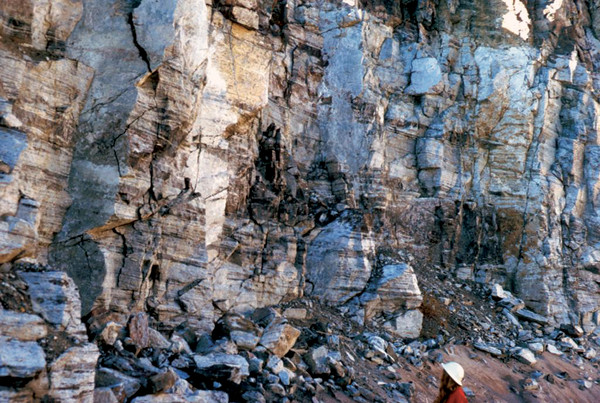
by U.S. Geological Survey Tuesday, January 27, 2015
U.S. Geological Survey Mineral Commodity Specialist Robert Virta and Resource Specialist Brad Van Gosen prepared the following information about wollastonite, an industrial mineral with sizable production only in five countries.

New York is the only U.S. state where long-term continuous mining of wollastonite has occurred. This mine in Lewis, N.Y., produces ores with up to 60 percent wollastonite. Credit: New York State Museum.
Wollastonite, a calcium metasilicate, has an ideal composition of 48.3 percent calcium oxide and 51.7 percent silicon dioxide, but it can also contain minor amounts of aluminum, iron, magnesium, manganese, potassium, sodium or strontium substituting for calcium. Wollastonite occurs as prismatic crystals that break into tabular-to-acicular fragments. It is usually white but also may be gray, cream, brown, pale green, or red depending on its impurities and grain size.
Wollastonite forms when impure limestones are metamorphosed or when silica-bearing fluids are introduced into calcareous sediments during metamorphism, in both cases through the reaction of calcium carbonate with silicon dioxide yielding calcium metasilicate and carbon dioxide. Less commonly, wollastonite can also crystallize directly from a magma that has high carbon content.
The wollastonite industry in the United States is small. Deposits of wollastonite have been identified in Arizona, California, Idaho, Nevada, New Mexico, New York and Utah, but in the last 60 years, it has been mined only in New York.
Wollastonite is used in automobile brakes, ceramics, metallurgical processing applications, paints and plastics. The properties that make it useful are its high brightness and whiteness, low moisture and oil absorption, low volatile content, and the acicular, or needle-shaped, morphology of some wollastonite.
In ceramics, wollastonite decreases shrinkage and gas evolution during firing, increases fired strength, maintains its brightness during firing, permits fast firing, and reduces glaze defects. In metallurgical applications, wollastonite serves as a flux for welding, a source of calcium oxide, a slag conditioner, and a coating to protect the surface of molten metal during the continuous casting of steel. As an additive in paint, it improves the durability of the paint film, acts as a pH buffer, improves its resistance to weathering and reduces pigment consumption. In plastics, it improves tensile and flexural strength, reduces resin consumption, and improves stability at high temperatures.
Wollastonite is a substitute for asbestos in floor tiles, friction products, insulating board and other materials because it is chemically resistant, inert and stable at high temperatures, and its acicular morphology improves flexural and tensile strength of the finished products.
For more information on wollastonite, visit http://minerals.usgs.gov/minerals.
In 2013, plastics and rubber applications accounted for 30 to 35 percent of U.S. sales of wollastonite, followed by ceramics (20 to 25 percent), metallurgical applications (10 to 20 percent), and paint, friction products and miscellaneous (10 to 15 percent each).
Global markets in 2013 for wollastonite were ceramics (30 to 40 percent), polymers (30 to 35 percent) and coatings (10 to 15 percent). The remaining sales were for construction, friction products and metallurgical applications.
In 2013, global production of refined wollastonite was estimated to be 500,000 to 540,000 metric tons. China was the leading producer, followed by India, the United States, Mexico and Finland. These five countries produced more than 97 percent of the wollastonite used worldwide.
Wollastonite was named for W.H. Wollaston (1766–1828), an English chemist and renowned mineralogist, who discovered palladium and rhodium (though not wollastonite).
Wollastonite is one of only a few minerals with a pyroxenoid crystal structure.
The wollastonite industry is relatively new, with limited commercial production starting in the 1930s and large-scale mining beginning only in the 1950s.
Wollastonite is used to manufacture products ranging from wheel covers for cars to glazes on bathtubs.
© 2008-2021. All rights reserved. Any copying, redistribution or retransmission of any of the contents of this service without the expressed written permission of the American Geosciences Institute is expressly prohibited. Click here for all copyright requests.